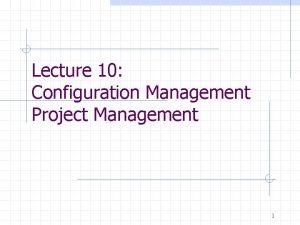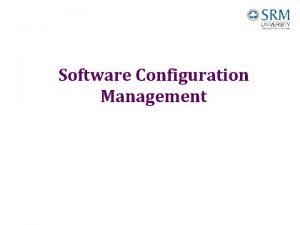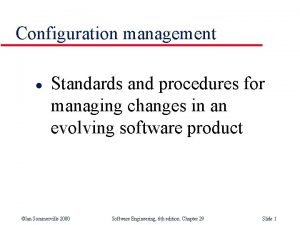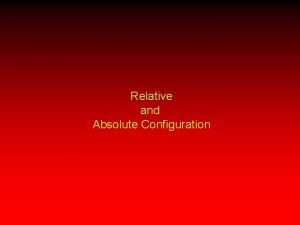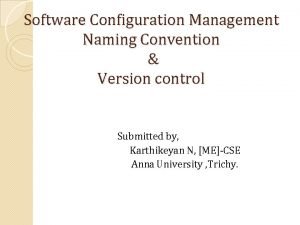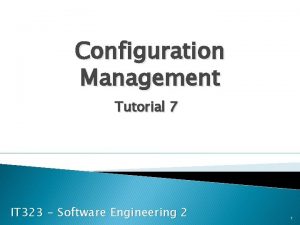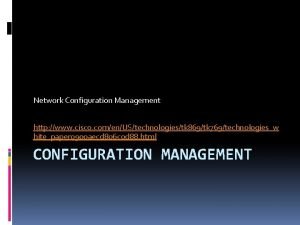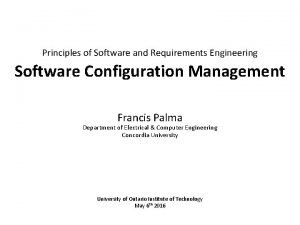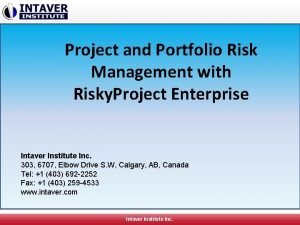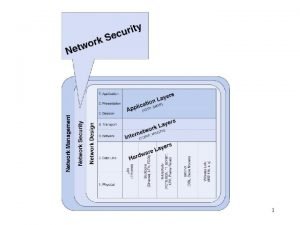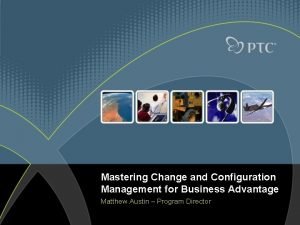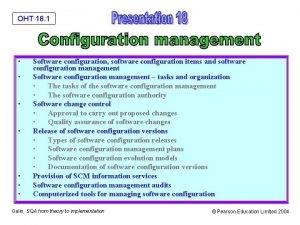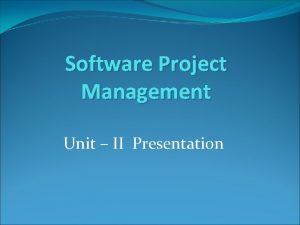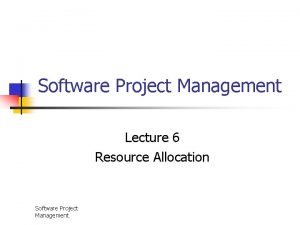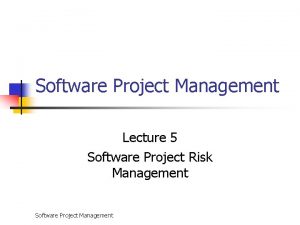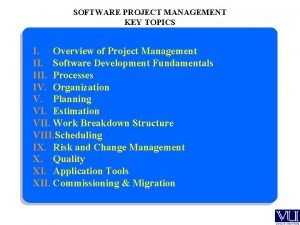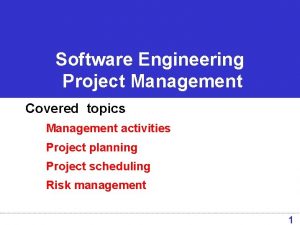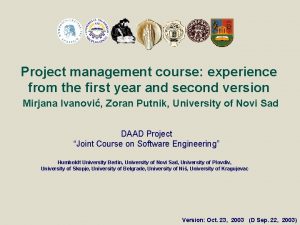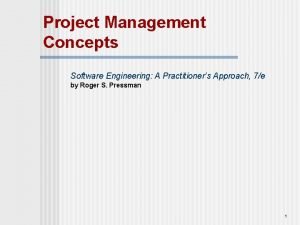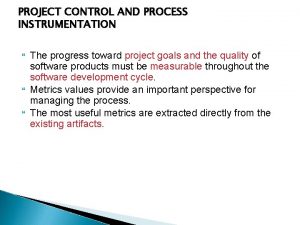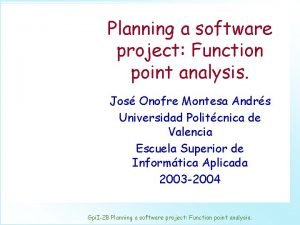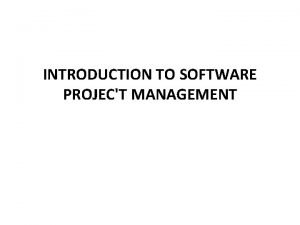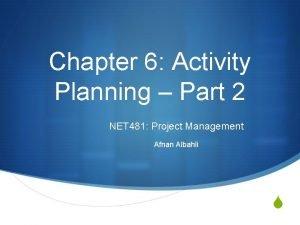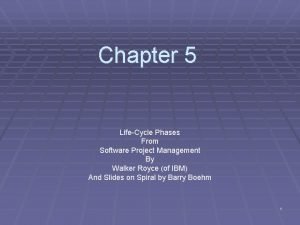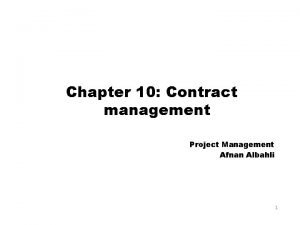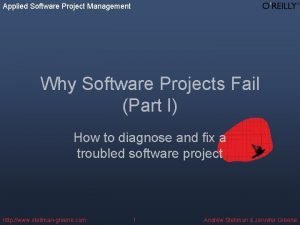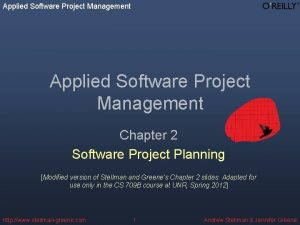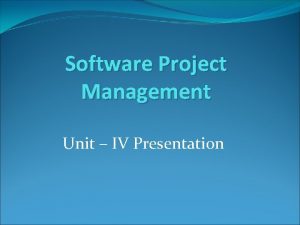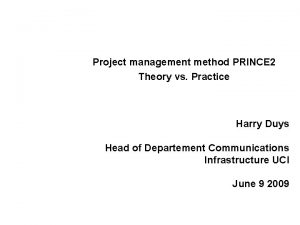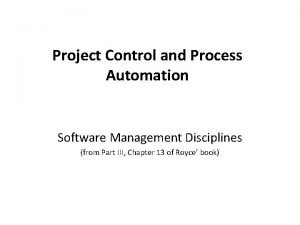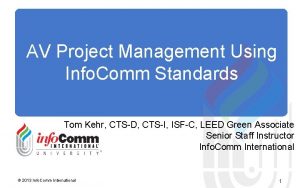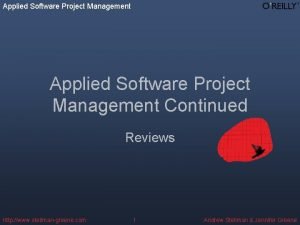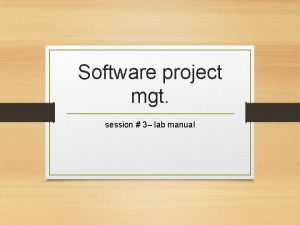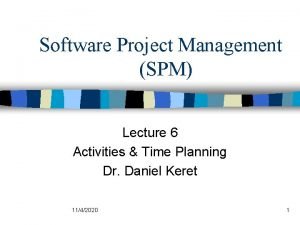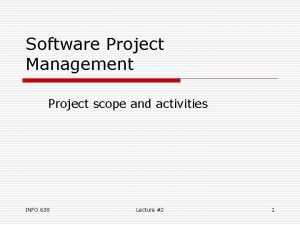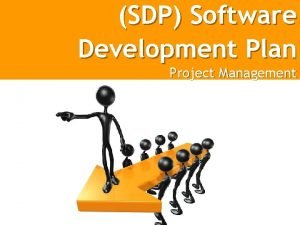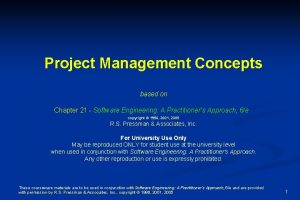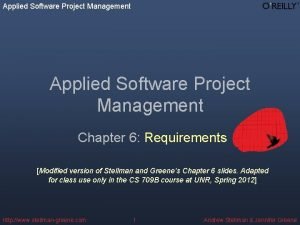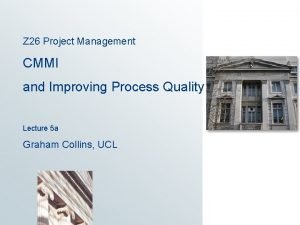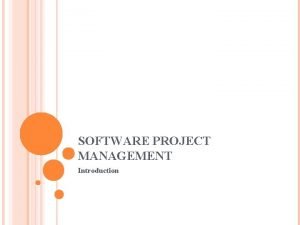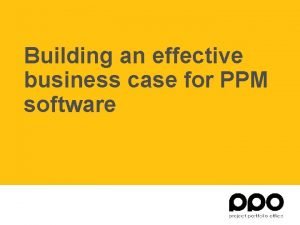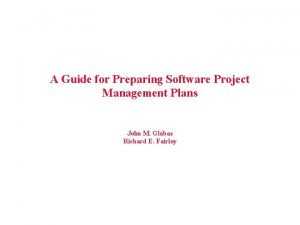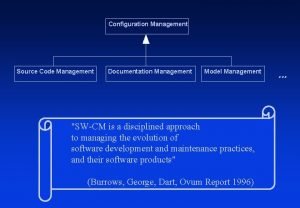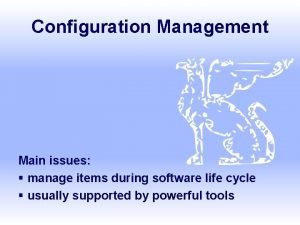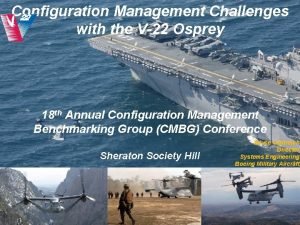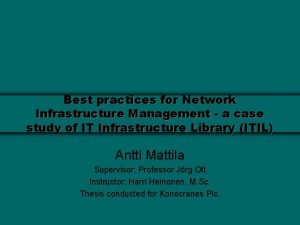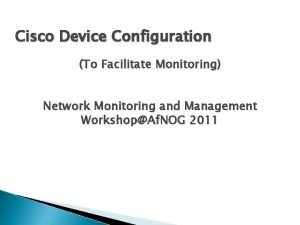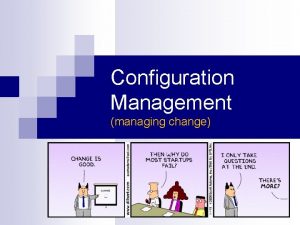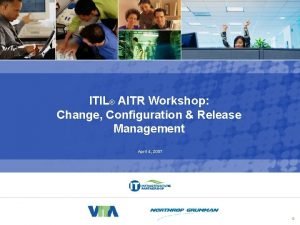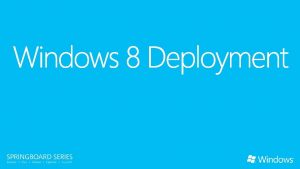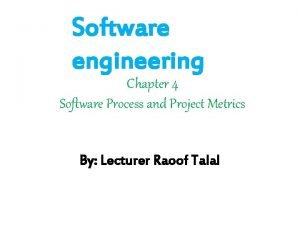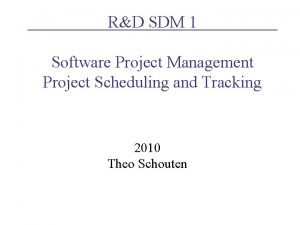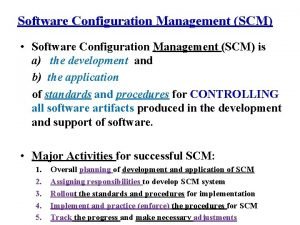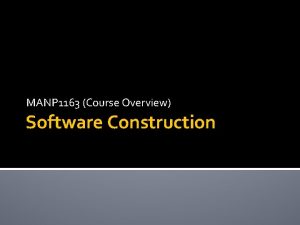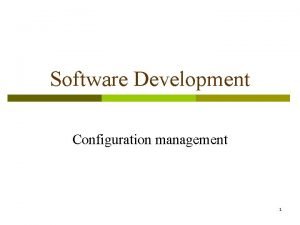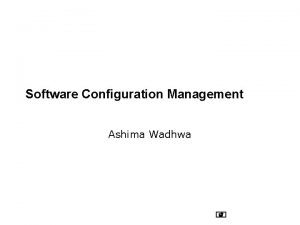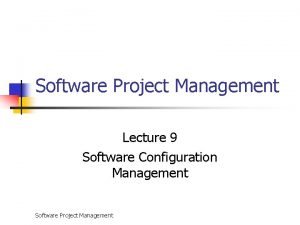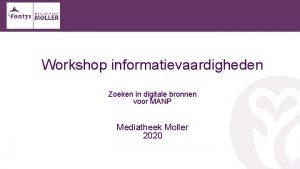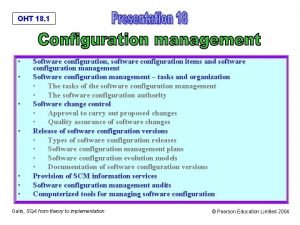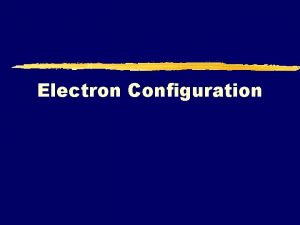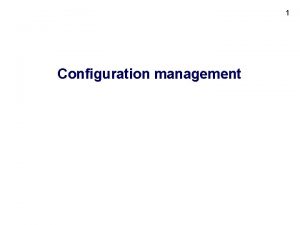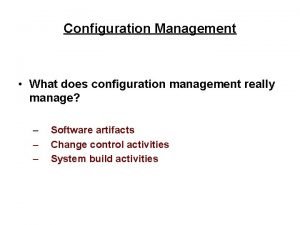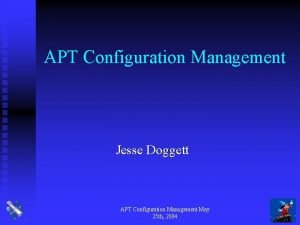Software Project and Configuration Management MANP 1433 Lecturer





































































































- Slides: 101

Software Project and Configuration Management MANP 1433 Lecturer: Suriayati Chuprat suriayati. kl@utm. my 1

Overview Course Objectives Course Materials Course Evaluation Course Contents 2

Course Objectives • To develop a complete software project plan adhering to a software engineering standard, which includes supporting software quality plan and risk management plan. • To organize and integrate the different roles and activities in a software development team based on the project plan. • To predict and handle issues involved in software project management and relating them to the factors affecting software quality. • To measure the software quality required adhering the software engineering standard in the project plan. • To plan configuration management process to a small software project environment. 3

Course Materials During the course the following material will be used: • Module handouts in UTM e-learning system • Reference books : – Software Project Management, 5 th edition by B. Hughes and M. Cotterell, Mc. Graw. Hill, 2009. – Mastering Software Project Management: Best Practices, Tools and Techniques, M. K. Chemuturi, T. M. Cagley Jr, J. Ross Publishing, 2010. – Configuration Management Best Practices: Practical Methods That Work in the Real World, Robert Aiello, Bob Aiello, Leslie Sachs, Addison Wesley, 2010. – Articles on Configuration Management, including: Software Configuration Management, Lcfg, Cfengine, Allfusion Harvest Change Manager, Quattor, Baseline (Configuration Management), Engineering Support, Component Repository Management, Haphaestus Books, 2011. 4

Course Evaluation • Coursework – – Tests (2) Written Assignment (2) Oral Presentation of Assignment Software Development Plan • Examination 60% (1) 20% 10% 40% 5

Course Contents • Software project management overview (2 h) • Software project initiation and scope definition (2 h) • Software project planning, effort, schedule and cost estimation (3 h) • Software project enactment (2 h) • Software project review and evaluation (1 h) • Software project closure (1 h) • Software engineering measurement (2 h) • Software measurement tools (1 h) • Presentation Case Study & hands on with SDP (6 h) • Software Development Plan reporting, review and evaluation (1 h) 6

Course Contents • • Software configuration management (SCM) overview (2 h) Management of SCM process (5 h) Software configuration identification (2 h) Software configuration control (2 h) Software configuration status accounting (3 h) Software configuration auditing (2 h) Software release management and delivery (2 h) Creating usage model using configuration management tool. (3 h) 7

“The most important software cost driver is poor management” Barry Boehm 8

INTRODUCTION 9

What is Software Engineering? • The engineering discipline was introduced to cater the poor quality of software, where projects exceeded time and budget and to ensure that software is built systematically, rigorously, measurably, on time, on budget and within specification. • ISO/IEC/IEEE Systems and Software Engineering Vocabulary (SEVOCAB) defines software engineering as : The application of a systematic, disciplined, quantifiable approach to the development, operation, and maintenance of software - that is, the application of engineering to software 10

Managing Software Project • Effective software project management has to take into account: – Client’s understanding of the project needs and its feasibility. – Complexity especially regarding the impact of changing requirements. – Increased understanding and changing conditions will generate new or changed software requirements iterative process to develop software. – A rapid rate of change in the underlying technology. 11

Project = Small business • Both project and small business: – Consume resources – Have stakeholders – Have critical success factors – Have financial targets 12

Recipe for Project Success? 13

Ingredients • Software development requires – Competent technologists – Competent managers – An effective organization structure 14

Method • A software development method presents: – a set of guidelines or approaches for software development processes – optimal choices for development tools and techniques, for high quality and cost-effective software products 15

TOPIC 1: SOFTWARE PROJECT MANAGEMENT OVERVIEW 16

What is a project? • A project is a temporary overlay on the standing organization • It is created to achieve a specific objective defined by a client within agreed time and budget • The standing organization is represented by the linemanagement • One project manager will manage the project • The project manager is responsible for the project and reports to the line-management 17

Project defined by PMI • A temporary group activity designed to produce a unique product, service or result. • A project is temporary in that it has a defined beginning and end in time, and therefore defined scope and resources. • And a project is unique in that it is not a routine operation, but a specific set of operations designed to accomplish a singular goal. 18

In other words • • • Projects have a purpose Projects are limited in time and space Projects have budget constraint Projects are collective Projects are unique Projects are realistic Projects are complex Projects are an adventure Projects can be assessed Projects are made up of stages 19

What is Project Management? • Project management deals with the complex knowledge-based teamwork in organizations going through very fast changes in business environments. • The purpose of project management is to carry out a series of activities as effective as possible. 20

Project management defined by PMI • the application of knowledge, skills and techniques to execute projects effectively and efficiently. It’s a strategic competency for organizations, enabling them to tie project results to business goals — and thus, better compete in their markets. 21

Work Package (PMI) • It is the effort required to produce a deliverable within a project. • This effort may be a single task or it could be several related tasks. 22

Software Work Package Purpose To provide at an agreed price and schedule, software that meets the (functional) requirements, negotiated with the customer and verifiable by the customer Size The Software Work Package may consist of one or a number of CSCI’s 23

Software Work Package Proposal Project initiation Define System req. definition/design Make Project realization Deliver System installation Other domains Product Baseline Contractual Baseline Functional Baseline Software Hardware Allocated Baseline Software Work Package 24

Software Work Package Top Man. Dept. Manager Software Project Manager Software Work Package Manager Dept. Man. 25

People involved Customer Project Manager Dep. Man. Software Work Package Manager Quality Ass. Manager Software Subcontractor Configuration Manager Software Developers System Eng. Group Support Group Test Group 26

Software work package managing steps • Setting-up and kick-off • Make sure that the input documents are ready, set up the environment, define the resources, enforce commitment • Production • Drive and control the execution of the work and of each participants commitment • Delivery • Carry out the product qualification, finalize the output documents, deliver them to the customer • Closing down • Evaluate the project, transfer the knowledge and resources to the support group 27

Software work package documentation • Management documentation – Software Development Plan (SDP) – Software Quality Program Planning (SQPP) • Engineering documentation – Allocated baseline: SRS, IRS – Design documentation: SDD, IDD – Internal documentation: project notes, project log, etc. – Product baseline: Software Product Specification (SPS), Version Description Document (VDD) • Quality assurance documentation – Audit and review reports – STP, STD, STR 28

Problems with software projects 29

Problems with software projects Software Product from different perspectives 30

Explain this scenario 31

Software Project Management must Manage to a Future Target • Business Changes – Market shifts and investment fluctuations – Portfolio changes – Mergers and Acquisitions • Technology Changes – Hardware, software, networks, mobile – Fast, better, cheaper • Process Changes – Agility vs. quality – Business and technology • Staffing Changes – Shortages and gluts 32

Software Engineering Management according to SWEBOK 33

TOPIC 2: SOFTWARE PROJECT INITIATION AND SCOPE DEFINITION - decision to embark on a software engineering project 34

Software Project Initiation: The process of formally recognizing that a new project exists or that an existing project should continue into its next phase. This formal initiation links the project to the ongoing work of the standing organization. 35

Projects are typically authorized as a result of A market demand A business need A customer request A technological advance A legal requirement 36

Initiation Input Product Description Strategic Plan Project Selection Criteria Historical Information Tools & Techniques Project Selection Method Expert Judgement Output Project Charter Project Manager assigned Constraints Assumptions 37

Inputs to Initiation • Product Description – Gather data – Identify need • Strategic Plan – Establish goals and objectives • Project Selection Criteria – E. g. financial returns • Historical Information – Past projects – Previous phase 38

Tools and Techniques for Initiation • Project Selection Methods (decision models) – Benefit measurement (e. g. through comparative approaches or scoring models) – Constrained optimization (mathematical based models) • Expert Judgments – Expertise from other units within the organization – Consultants – Professional and technical associations – Industry groups 39

Outputs from Initiation • Project Charter – A document formally recognizes the existence of a project. • Project manager identified/assigned – Assigned prior to the start of the project plan execution, preferably before much project planning has been done. • Constraints – Factors limiting the team’s options. • Assumptions – Factors that will be considered to be true, real or certain. 40

Project Charter A document issued by senior management to the project manager to apply organizational resources to project activities. • Includes the business need the project is to address • Establishes the scope of the project • Includes the product description • Names the project manager as the responsible and authorized party • Identifies the project deliverables, schedule and budget • Is concise 41

Project Charter http: //www. sixsigmadaily. com/tag/project-charter 42

Role of the project manager • A project manager acts as the single point of contact on a project. • He/She is the individual responsible for: • planning and organizing the work • managing the day to day activities • delivering the project to the client 43

Responsibilities of a project manager • • • Project planning Managing the project Lead project team Building client partnerships Targeting to the business 44

Responsibilities of a project manager �Project planning Develops preliminary study with project team, identifying business problem, requirements, project scope and benefits Identifying key project results and milestones Develops project plan and work breakdown structure and communicates to team and client Determines needed resources including client involvement Estimates timelines and phases Influences selection of project team members Assigns project responsibilities based on assessment of individual skills and development needs Defines clear individual roles and performance expectations Establishes acceptance criteria Determines appropriate technological approach 45

Responsibilities of a project manager • Managing the project Continually reviews project status Reviews work against key results criteria Uses systematic method for logging project status, checking against schedule Uses change management/request procedure Uses project meetings to measure progress against plan, communicate changes and issues Assesses skill-needed documentation of meetings, work, conversations, and decisions Measures quality through testing against requirements Conducts project reviews and walk-throughs with appropriate client involvement 46

Responsibilities of a project manager • Lead project team – Involves team in planning – Uses both formal and informal methods to track project status – Recognizes individual and team accomplishments or results – Manages performance issues in a timely manner & delegates tasks effectively based on understanding individual strengths and weaknesses – Maintains open door for staff ideas and concerns – Sets performance and development objectives for staff – Schedules and holds regular team meetings 47

Responsibilities of a project manager • Building client partnerships – Involves working jointly with client in defining project goals and key results – Works with client to ensure alignment of project to overall business goals – Listens and responds actively, documents client needs, changes and demands – Implements procedures for controlling and handling change – Develops client understanding of the system and trains in systems use – Presents and reports periodically to client – Establishes lines of responsibility and accountability to client 48

Responsibilities of a project manager • Targeting to the business Manages in accordance with visions and values Links overall architecture principles Interfaces effectively with business systems and processes Plans for impacts on related systems departments to achieve maximum efficiency – Understands business needs, time and cost pressures – Keeps current with business and technology developments in competitors – Aligns project with corporate and business priorities and direction – – 49

Assessing Project Managers • Skills and competencies are the two characteristics that determine the success or failure of a project manager • Skills – – At the visible level Level of mastery can be measured Can be acquired through trainings Examples: estimating time & estimating cost • Competencies – Traits that lie below the surface – Visible in practice – Immeasurable in the sense of determining whether a person has them and, if so, to what degree. – Difficult to develop through training – Some are hereditary 50

Criteria of a good Project Manager • A well rounded project manager must have skills and competencies in the following categories: – Business: related to the business and business processes in general and do not involve specific business function knowledge – Personal: relate to individual. These skills do not involve another party in order to be practiced – Interpersonal: relate to the individual. Involve at least two people, neither one of which is the manager of the other – Management: relate to all aspects of management either people management or work management. Also related to the performance of strategic and tactical management functions not specific to any individual 51

Classification of Project Managers �Team leader – Responsible for part of the project. – Generally assigned responsibility for an activity and can have a small number of staff assigned to the activity whose work they will manage �Project manager – Responsible for projects that are classified as simpler, less complex, lower risk or not mission-critical �Senior project manager – More experienced than the previous classes – Qualified to manage projects that are more complex, higher risk or mission -critical �Program managers – Reserved for those who have achieved the highest level of professionalism and experience in project management – Often manages project managers on very complex or multi-project undertakings 52

Constraints • For a contracted project, contractual provisions are generally the constraints. • Example of constrain is predefined budget. This will limit the team’s option regarding – Scope – Staff – schedule 53

Assumptions • Normally involve a degree of risk. • Can be identified early or they may be the result of risk identification. 54

Scope Subdividing major project deliverables into more manageable components to: • Improve accuracy of cost, time and resource estimates. • Define a baseline for performance measurement and control • Facilitate clear responsibility assignments 55

Scope • Critical to project success. • Poor scope definition leads to higher project costs due to inevitable changes that disrupt the project. • The output of scope is the Work Breakdown Structure (WBS) 56

Work Breakdown Structure (WBS) • Detailed representation of the scope of the project expressed in terms of work, resource and cost • A hierarchical decomposition of work (tasks) needed to produce a system • It provides: – Assistance in creating a clear allocation of responsibilities for work, resources and cost – A logical structure for cataloging all work elements • Must be updated regularly (tasks can be added, modified or removed) 57

WBS Relationships Supplier Management Plan Status Reporting Change Management Organization WBS System Solution Plans, Review Documentation Integration Strategy Cost Estimation Project Schedule 58

WBS Format Indented List Tree Structure 1. 1 xxxxxxx 1. 1. 2 xxxxxxx Project 1. 0 1. 2 xxxxxxx 1. 2. 1 xxxxxxx 1. 2. 2 xxxxxxx 1. 3 xxxxxxx AB 1. 1 1. 3. 1 xxxxxxx 1. 3. 2 xxxxxxx XX 1. 2 YY 1. 3 1. 4 xxxxxxx 1. 1. 1. 2. 1 1. 2. 2 1. 3. 1 59

Example of WBS view Prototype Installation 1. 1 System Set Up 1. 1. 1 Prepare Site 1. 1. 2 Verify HW 1. 2 Application Acceptance 1. 1. 3 Verify SW 1. 3 Change Requirement 1. 4 Prototype Acceptance 1. 2. 1 Prepare Test Script 1. 3. 1 Prepare Change Requirement 1. 2. 2 Review Test Script 1. 3. 2 Update Application 1. 4. 2 Evaluate Acceptance 1. 2. 3 Prepare & Load Test Data 1. 3. 3 Accept Change Requirement 1. 4. 3 Finalize Acceptance 1. 4. 1 Conduct Acceptance Test 1. 2. 4 Conduct Test 60

Exercise on WBS 61

TOPIC 3: SOFTWARE PROJECT PLANNING, EFFORT, SCHEDULE AND COST ESTIMATION 62

Software Project Planning • The first step should be selection of an appropriate software development life cycle model – perhaps tailoring it based on project scope, software requirements and a risk assessment. • Other factors to be considered include – the nature of the application domain, functional and technical complexity – software quality requirements 63

Software development lifecycle (SDLC) • No general rule specifying exactly the single phases, included in a software lifecycle or fixing their order • Most software lifecycles are phased processes with clearly identifiable goals, milestones, and tasks, which can be summarized to general activities such as: – – – Requirements analysis Design Implementation Testing Maintenance 64

65

SDLC • No ideal process model • Hybrid solution - "Mix-and-match" lifecycle model • Process model should be specified at the beginning of the project • Risk analysis and resolution are significant for process control 66

Project Management Activities • • Planning Controlling Organizing Staffing Directing Monitoring Innovating Representing 67

Planning and control of a project �Items of planning and control �Work with a control cycle �Execute the project in phases �Define the baselines �Management structure (Project vs Line Management) 68

Items of planning and control • Budget • Time • People • Software Quality Assurance • Commitment 69

Project Plan • An iterative activity, providing a means for effective management of a software project. • It tries to avoid problems and prepare possible solutions. • There is no fixed list how to do it, but a typical plan might include an analysis of project constraints (including, e. g. delivery date, available staff and expertise, budget) resulting to the specification of approximate project parameters, e. g. : – project structure, – project size, – product functions and their relationships. 70

Criteria of a Project Plan • Goals and objectives of the product • Work Breakdown Structure (WBS) • Resource estimates • Project schedule (when to deliver? ) • Risk analysis • Quality considerations • Configuration Management Issues • Testing • Contingency or exceptions 71

How to make a Project Plan? Develop WBS Estimate Develop Network Create Schedule 72

Estimation • It is about: – determining the project scope’s constraints – investigating the quality as required by the client – preparing the project schedule and budget – adjusting to the available resources – taking into consideration the project risks 73

Estimation • Is used to study and to predict the resources or time necessary to implement requirements • Can be used to draw up project or even iteration plans • Is used to analyse the viability of the investment analysis, to come up with a realistic pricing and to bid for a project competitively 74

Estimation • Therefore proper project planning and control is not possible without a sound and reliable estimate • Estimating size and cost are one of the most important topics in the area of software project management 75

Software Estimates • Unlike other types of projects, software is an intangible product where specifications are not very obvious especially at its initial stages • This characteristic puts software in a delicate position where inconsistency and vagueness of the project attributes makes the work estimation more difficult 76

Software Estimates • In a project it is very important to know: - how long will it take - how much effort will be required - how many people will be involved - how many resources do I need - what are the risks 77

What to estimate? • Effort • Activity duration • Resources: – People – Equipment • Materials • Cost – Direct (e. g. space rental) – Indirect (e. g. management cost) 78

Estimating Terms • Effort: the number of labour units required to complete an activity or other project element • Duration: number of work periods required to complete an activity or other project element. • Continuous duration is work time that is not interrupted. • Interruptible duration is work time that might be interrupted. • Resources: any necessary item that might be directly used in & charged to the project • Direct costs: labor, materials, equipment, services and fees that are charged to the project & must be traceable • Indirect costs: overhead & admin expenses. Overhead might include user training (course development, classroom costs, etc) 79

When to estimate? • Estimate is done many times throughout the project lifecycle • Prepare estimates: After WBS is developed When determining whether to bid on an opportunity When taking over a project to validate proposal estimates When moving to the next phase of a project When an assumption proves to be invalid When the WBS changes to ascertain the effort and cost associated with the changes – When there authorized changes in resources, materials or services – – – 80

How to estimate? • Software estimation is one of the most challenging and important activities in software development. • Software estimation can never be an exact science • Combination of good historical data and the use of a method can improve estimation accuracy 81

Estimation Types • A few elements are to be considered when choosing the right method to estimate software development: – team’s experience – the estimated lines of codes (LOC) to be delivered – the programming language used – the complexity of the software – the design methodologies – the environment for the tests to be conducted etc. 82

Estimation Types • From the point of view of the input data, estimation methods can be divided into three groups: – data-intensive – expert-based – hybrid methods 83

Data-intensive method • The prediction relies upon an accurate estimation of: – the software size – its complexness – the number of interfaces needed or the number of screens • Made up of mathematics and statistics equations • Fixed and predefined • The input parameters have to be derived from various project properties in order to obtain a more precise estimation 84

Expert-based method • The characteristics include learning, inferring and analyzing previous projects • Among the well known expert-based software models are the ones using soft computing methodologies like artificial neural networks (ANN), fuzzy logic (FL) and evolutionary computing (EC) which cater for real life situations where things are vague and flexibility is required to handle each one of them • Expert Judgement is the most commonly used technique but difficult to verify the accuracy of the results • Analogy Based Estimation (ABE) is a simple & flexible 85

Hybrid • Hybrid means combining the available data and expert knowledge in order to come up with a good estimate • The models are built by integrating expert opinion and data-driven techniques • Assumed to work better because there is no isolate technique that does not have any flaw nor one that can be accepted by everyone and hybridizing a few approaches is hoped to produce more realistic estimations 86

Planning Estimation • Establish the estimating objectives – – Why are they being prepared? What is the required accuracy? Who is the intended audience? When are the estimates needed? • Determine the project details – Identify required information to prepare estimates • Select the appropriate model • Develop the estimating strategy and plan – Identify estimators – Develop a plan to gather the estimates – Review history of similar projects 87

Key factors in Software Estimation • Project Manager has to balance between: – Cost – Schedule – Quality • Project costs involve: – Hardware costs – Travel and training costs – Effort costs 88

Software Cost Estimation �Software cost estimation is the process of predicting the amount of effort required to build a software system. �Cost estimates are needed throughout the software lifecycle. �Examining projects & characteristics helps develop underlying theory of how software development works & what factors generate highest costs. �Cost model gives us some idea of what project will cost. �Cost modeling is imprecise and difficult – it is important as a planning & evaluation tool. 89

Software Cost Estimation • Size is a primary cost factor in most models. There are two common ways to measure software size: – lines of code – function points • Lines of Code: The most commonly used measure of source code program length is the number of lines of code (LOC) • Function points (FP): measure size in terms of the amount of functionality in a system. 90

Software Cost Estimation • Software project managers must estimate how much a software development is going to cost for the project budget. • Types of costs: – Facilities costs • Hardware & software costs • Costs for physical space for team – Project management costs • • Standards Training Travel Management methods – People costs • Salary 91

Effort • Effort is the number of labour units required to complete an activity or other project element • The estimated range of effort required for a project, or parts of a project, can be determined using: – a calibrated estimation model based on historical size and effort data (when available) – other relevant methods such as expert judgment and analogy • Task dependencies can be established and potential opportunities for completing tasks concurrently and sequentially can be identified and documented using a Gantt chart, for example. 92

Software Effort Estimation • After sizing the product (functional size measurement), the effort to be expended shall be estimated in person months (or hours) using the size and additional estimation parameters • The estimated effort is distributed across the phases of the project as the basis for project planning and scheduling • For the total project plan, an estimate must also be made for the effort for project management and quality assurance • Often the project management and quality assurance efforts are overlooked or forgotten, and this leads to severe miscalculations and underestimating 93

Schedule • Determine the start and finish dates for project activities. • If the start and finish dates are not realistic, the project is unlikely to be finished as scheduled. • The schedule development process must often be iterated (along with the processes that provide inputs, especially duration estimating and cost estimating) prior to determination of the project schedule. 94

Software Schedule Estimation • Early and precise estimations are necessary and desirable by software clients • However, early estimations are usually imprecise and prone to a high degree of uncertainty • Estimates must be updated and revised whenever important influencing factors change • If changes are not considered and actualized, the plan made from the original estimation will never be met 95

Software Schedule Estimation Suggestion for Milestones for IT project estimation (Bundschuh & Dekkers, 2008) 96

Estimate is … • An assessment of the likely quantitative result • An approximate judgment of the effort, cost & time to perform a specified piece of work • A quotation for a piece of work that cannot be exceeded without notice given • A document containing resources & consumption: – What resources require? – Who will supply them? – When are they needed? – How long they are needed? 97

Estimate is not … • • • Account strategy Pricing Investment marketing Client satisfaction Software or tools Finding the fastest way 98

Conclusion on Estimation • Estimation contributes to making process improvements measurable • Estimate as much as possible • Estimation must be used cautiously • Implement several techniques • Most important: make use of historical data 99

Discussion #1 About software estimate: • "It takes too much time. " • "They're not useful. " • "They'll be wrong. " So, why do we still need to do estimate? 100

Discussion #2 • If it takes 5 people 8 hours to build a wall, how many hours will it take for 10 people to build the same wall? 101
 Lecturer's name or lecturer name
Lecturer's name or lecturer name Software configuration management definition
Software configuration management definition Configuration management in project management
Configuration management in project management Scm control enables team to
Scm control enables team to Software configuration management basics and standards
Software configuration management basics and standards Modern process transitions in spm
Modern process transitions in spm Software project evaluation
Software project evaluation Improve software economics
Improve software economics Example of relative configuration
Example of relative configuration Chiral and achiral meaning
Chiral and achiral meaning Electron configuration vs noble gas configuration
Electron configuration vs noble gas configuration What is relative configuration
What is relative configuration Jeannie watkins
Jeannie watkins Spe distinguished lecturer
Spe distinguished lecturer Good morning students
Good morning students Photography lecturer
Photography lecturer Lecturer in charge
Lecturer in charge Designation lecturer
Designation lecturer Designation of lecturer
Designation of lecturer Gcwak
Gcwak Lecturer name
Lecturer name Pearson lecturer resources
Pearson lecturer resources Spe distinguished lecturer
Spe distinguished lecturer Lector vs lecturer
Lector vs lecturer Lecturer in charge
Lecturer in charge Cfa lecturer handbook
Cfa lecturer handbook Lecturer asad ali
Lecturer asad ali Software configuration management version control
Software configuration management version control Configuration management tutorial
Configuration management tutorial Edward h. bersoff
Edward h. bersoff Cisco configuration management
Cisco configuration management Principles of software configuration management
Principles of software configuration management Introduction for project
Introduction for project The intent of project metrics is:
The intent of project metrics is: Portfolio risk register
Portfolio risk register Configuration management a&d
Configuration management a&d Performance and configuration management
Performance and configuration management Windchill configuration management
Windchill configuration management Plena voice alarm system configuration software
Plena voice alarm system configuration software Site:slidetodoc.com
Site:slidetodoc.com The role of project management in achieving project success
The role of project management in achieving project success Reducing project duration examples
Reducing project duration examples Modern project management began with what project
Modern project management began with what project Perpetual project closure
Perpetual project closure Microsoft project agile template
Microsoft project agile template Types of terminations
Types of terminations Effective software project management
Effective software project management Strategic assessment in spm
Strategic assessment in spm Resource allocation in software project management
Resource allocation in software project management Software project risk
Software project risk Software project management topics
Software project management topics Activities covered by software project management
Activities covered by software project management Project management notes
Project management notes Project management tools in software engineering
Project management tools in software engineering 4 p's of project management in software engineering
4 p's of project management in software engineering Seven core metrics of software project
Seven core metrics of software project Function point analysis in project management
Function point analysis in project management Software
Software Pragmatic artifacts in software project management
Pragmatic artifacts in software project management Activity based approach in software project management
Activity based approach in software project management Life cycle phases in software project management
Life cycle phases in software project management Stages in contract placement in spm
Stages in contract placement in spm Applied software project management
Applied software project management Applied software project management
Applied software project management Forward pass definition project management
Forward pass definition project management Spm unit 4 notes
Spm unit 4 notes Step wise project planning
Step wise project planning Prince 1 project management
Prince 1 project management Seven core metrics in software project management
Seven core metrics in software project management Av project management software
Av project management software Applied software project management
Applied software project management Software project management lab manual
Software project management lab manual Spm activities
Spm activities Scope of activities example
Scope of activities example Sdp project ideas
Sdp project ideas 4 p's of project management in software engineering
4 p's of project management in software engineering Contoh wbs proyek website
Contoh wbs proyek website Uml diagram for gym management system
Uml diagram for gym management system Aon aoa
Aon aoa Applied software project management
Applied software project management Cmmi project management
Cmmi project management Software project objectives
Software project objectives Ppm tool business case
Ppm tool business case Project management software
Project management software What is spmp in software engineering
What is spmp in software engineering Aircraft configuration management
Aircraft configuration management Source code configuration management
Source code configuration management Configuration management challenges
Configuration management challenges Configuration management challenges
Configuration management challenges Cherwell configuration management
Cherwell configuration management Network infrastructure best practices
Network infrastructure best practices Cisco device configuration management
Cisco device configuration management Configuration management questions
Configuration management questions Change configuration & release management
Change configuration & release management Configuration management for web engineering
Configuration management for web engineering Configuration management challenges
Configuration management challenges Asset management vs project management
Asset management vs project management Principles of cost management
Principles of cost management Focusing on broad organizational needs
Focusing on broad organizational needs Process and project metrics in software engineering
Process and project metrics in software engineering Project scheduling in software engineering
Project scheduling in software engineering Project metrics in software engineering
Project metrics in software engineering


